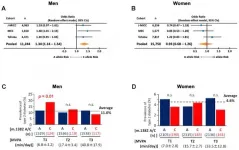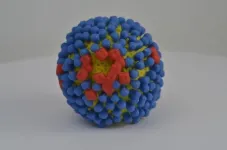INFORMATION:
A team of climatologists is studying how to minimize errors in observed climate trend
Experts in climatology from the Universitat Rovira i Virgili, the State Meteorology Agency and the University of Bonn (Germany) make headway in identifying the most reliable methods that help to correct these biases
2021-02-03
(Press-News.org) The instrumental climate record is the cultural heritage of humankind, the result of the diligent work of many generations of people all over the world. However, the changes in the way in which temperature is measured, as well as the environment in which weather stations are located can produce spurious trends. An international study carried out by researchers from the Universitat Rovira i Virgili (URV), the State Meteorology Agency and the University of Bonn (Germany) have succeeded in identifying the most reliable methods that help correct these trends. These "homogenization methods" are a key step in converting the enormous effort made by observers into reliable data about climate change. The results of this research, funded by the Spanish Ministry of Economy and Competitiveness, have been published in the Journal of Climate of the American Meteorological Society.
Climate observations can often be traced back more than a century, even before there were cars and electricity. These long periods of time mean that it is practically impossible to maintain the same measuring conditions over the years. The most common problem is the growth of cities around urban weather stations. We know that cities are getting warmer and warmer because of the thermal properties of urban surfaces and the reduction of evapotranspiration surfaces. To verify this, it is sufficient to compare urban stations with nearby rural stations. Although less known, similar problems are caused by the expansion of irrigated crops around observatories.
The other most common reason for biases in observed data is that weather stations have been relocated, among other reasons, because of changes in the observation networks. "A typical organisational change consisted of weather stations, which used to be in cities, being transferred to newly built airports which needed observations and predictions," explains Victor Venema, a climatologist from Bonn and one of the authors of the study. "The weather station in Bonn used to be in a field in the village of Poppelsdorf, which is now a part of the city and, after it had been moved several times, it is now in the Cologne-Bonn airport," he says.
As far as the robust estimation of global trends is concerned, the most important changes are technological, which are made simultaneously in an observation network. "At the moment we are in the middle of a period of generalised automation of the observation networks," says Venema.
The computer programs that can be used for the automatic homogenisation of climate time series data are the result of several years of development. They operate by comparing stations that are near to each other and looking for changes that only take place in one of them, unlike climate changes, which affect them all.
To examine these homogenization methods, the research team generated a test bank in which they incorporated a set of simulated data that reliably imitated the sets of observed climate data, including the biases mentioned. Hence, the spurious changes are known and they can be studied to determine how the various homogenisation methods can correct them.
The test data sets generated were more diverse than those in previous studies and so were the real networks of stations, because of differences in how they were used. The researchers reproduced networks with highly varied densities of stations because in a dense network it is easier to identify a small spurious change in one station. The test data set that was used in this project was much larger than in previous studies (a total of 1,900 weather stations were analysed), which enabled the scientists to accurately determine the differences between the main automatic homogenisation methods developed by research groups in Europe and America. Because of the large size of the test data set, only the automated homogenisation methods could be tested.
The research group discovered that it is much more difficult to improve the estimated mean climate signal for an observation network than improve the accuracy of the time series of each station.
In the resulting classification, the methods of homogenisation proposed by URV and AEMET were better than the others. The method developed at the URV's C3 Centre for Climate Change (Vila-seca, Tarragona) by the Hungarian climatologist Peter Domonkos proved to be the best at homogenising both the series from individual stations and the mean series from the regional network. The AEMET method, developed by the researcher José A. Guijarro, was very close behind.
The homogenisation method developed by the National Oceanic and Atmospheric Administration of the United States (NOAA) was best at detecting and minimising systematic errors in trends from many weather stations, especially when these biases were produced simultaneously and affected many stations on similar dates. This method was designed to homogenise data sets from stations the world over where the main concern is the reliable estimation of global trends.
The results of this study have demonstrated the value of large test data sets. "It is another reason why automatic homogenisation methods are important: they can be tested more easily and this helps in their development," explains Peter Domonkos, who started his career as a meteorological observer and is now writing a book on the homogenisation of climate time series.
"The study shows the importance of very dense station networks in making homogenisation methods more robust and efficient and, therefore, in calculating observed trends more accurately," says the researcher Manola Brunet, director of the URV's C3, visiting member of the Climate Research Unit of the University of East Anglia, Norwich, United Kingdom, and vice-president of the World Meteorological Organisation's Commission for Weather, Climate, Water and Related Environmental Services & Applications.
"Unfortunately, much more climate data still has to be digitalised for even better homogenisation and quality control," she concludes.
For his part, the researcher Javier Sigró, also from the C3, points out that homogenisation is often just the first step "that allows us to go to the archives and check what happened with those observations affected by spurious changes. Improving the methods of homogenisation means that we can do this much more efficiently."
"The results of the project can help users to choose the method most suited to their needs and developers to improve their software because its strong and weak points are revealed. This will enable more improvement in the future," says José A. Guijarro from the State Meteorology Agency of the Balearic Islands and co-author of the study.
Previous studies of a similar kind have shown that the homogenisation methods that were designed to detect multiple biases simultaneously were clearly better than those that identify artificial spurious changes one by one. "Curiously, our study did not confirm this. It may be more an issue of using methods that have been accurately fitted and tested," says Victor Venema from the University of Bonn.
The experts are sure that the accuracy of the homogenisation methods will improve even more. "Nevertheless, we must not forget that climate observations that are spatially more dense and of high quality are the cornerstone of what we know about climate variability," concludes Peter Domonkos.
ELSE PRESS RELEASES FROM THIS DATE:
What the Biden-Harris administration means for chemistry
2021-02-03
The inauguration of Joe Biden and Kamala Harris marks a new era for science policy in the U.S. and beyond. The new administration has inherited a global pandemic and worsening climate change, among other science-related issues. A cover story in Chemical & Engineering News (C&EN), the weekly newsmagazine of the American Chemical Society, delves into what this means for chemists and chemistry as a whole.
One of the most pressing issues facing the Biden administration is the fight against climate change. Biden campaigned on net-zero emissions of greenhouse gases by 2050 and has laid out a sweeping plan to switch the U.S. to cleaner energy sources, which experts say ...
Biodiversity is its own catalyst -- to a point
2021-02-03
For decades, scientists have wrestled with rival theories to explain how interactions between species, like competition, influence biodiversity. Tracking microbial life across the planet, researchers from McGill University show that biodiversity does in fact foster further diversity in microbiomes that are initially less diverse. However, diversity rates plateau with increased competition for survival and space in more diverse microbiomes.
Published in eLife, the findings could help scientists better understand how microbiomes - communities of micro-organisms living together in particular habitats like humans, animals and plants or even soils and oceans ...
Aging-US: A pro-diabetogenic mtDNA polymorphism in mitochondrial-derived peptide
2021-02-03
C polymorphism is associated with susceptibility to T2D in men, possibly interacting with exercise, and contributing to the risk of T2D in sedentary males by reducing the activity of MOTS-c.
Dr. Noriyuki Fuku from The Juntendo University and Dr. Pinchas Cohen from The University of Southern California said, "The prevalence of type 2 diabetes mellitus (T2D) is growing dramatically."
While diabetes syndromes directly caused by mutations in mtDNA are extremely rare, several genetic analyses reveal that mtDNA polymorphisms contribute to T2D risk in both European ...
Aging-US: Screening Alzheimer's disease by facial complexion using artificial intelligence
2021-02-03
Aging-US published "Screening of Alzheimer's disease by facial complexion using artificial intelligence" which reported that despite the increasing incidence and high morbidity associated with dementia, a simple, non-invasive, and inexpensive method of screening for dementia is yet to be discovered.
This study aimed to examine whether artificial intelligence could distinguish between the faces of people with cognitive impairment and those without dementia.
121 patients with cognitive impairment and 117 cognitively sound participants were recruited for the study.
The binary differentiation of dementia / non-dementia facial image was expressed as a "Face AI score".
However, MMSE score showed significantly stronger ...
Aging-US: Sulforaphane promotes C. elegans longevity and healthspan
2021-02-03
Aging-US published "Sulforaphane promotes C. elegans longevity and healthspan via DAF- 16/DAF-2 insulin/IGF-1 signaling" which reported that the broccoli-derived isothiocyanate sulforaphane inhibits inflammation, oxidative stress and cancer, but its effect on healthspan and longevity are unclear.
The authors used the C. elegans nematode model and fed the wildtype and 9 mutant strains ±sulforaphane.
Sulforaphane increased the lifespan and promoted a health-related phenotype by increasing mobility, appetite and food intake and reducing lipofuscin accumulation.
Mechanistically, sulforaphane inhibited DAF-2-mediated insulin/insulin-like growth factor signaling and its downstream targets AGE-1, AKT-1/AKT-2. This was associated with increased nuclear translocation of ...
COVID-19 vaccination for patients with Parkinson's disease recommended
2021-02-03
Amsterdam, NL, February 3, 2021 - Patients with Parkinson's disease (PD) and healthcare professionals caring for them have expressed concerns about the COVID-19 vaccine's efficacy and safety in the specific context of PD and its symptomatic treatment. In a END ...
Intranasal influenza vaccine spurs strong immune response in Phase 1 study
2021-02-03
WHAT:
An experimental single-dose, intranasal influenza vaccine was safe and produced a durable immune response when tested in a Phase 1 study published in the Journal of Clinical Investigation. The investigational vaccine, called Ad4-H5-VTN, is a recombinant, replicating adenovirus vaccine designed to spur antibodies to hemagglutinin, a protein found on the surface of influenza viruses that attaches to human cells.
The investigational vaccine was developed by Emergent Biosolutions Inc., (Gaithersburg, Maryland). It was administered intranasally (28 study participants), as an oral capsule (10 participants) and via a tonsillar swab (25 participants) to ...
Extreme blood sugar swings in people with type 2 diabetes may increase heart disease risk
2021-02-03
BATON ROUGE, LOUISIANA - In patients with type 2 diabetes, big swings in blood sugar levels between doctors' visits are associated with an increased risk of heart disease.
The study, published in the journal Diabetes, Obesity & Metabolism, looked at more than 29,000 patients with type 2 diabetes over a two-year period. Patients who already had heart disease were excluded.
The American Diabetes Association recommends adults with diabetes maintain an A1c, the average blood sugar level over the past two to three months, of less than 7 percent to reduce complications from diabetes, such ...
Research looks at the link between procedures and everyday practice in community pharmacy
2021-02-03
A study published in the journal Applied Ergonomics compared the standardised processes set out for community pharmacists to follow when dispending medication to what happens in reality. A gap was revealed and researchers also looked at the reasons for this.
The research, "Mind the gap: Examining work-as-imagined and work-as-done when dispensing medication in the community pharmacy setting"*, was conducted by the National Institute for Health Research Greater Manchester Patient Safety Translational Research Centre (NIHR GM PSTRC). The Centre is a partnership between The University of Manchester and Salford Royal NHS Foundation Trust.
The research involved observing pharmacists and pharmacy staff as they conducted the task of dispensing, ...
Sneakerheads, not hypebeasts: Defining a sneaker-driven sub-culture
2021-02-03
Sneakers can be about style, history and even community. A new study reveals that for "Sneakerheads," sneakers are an important facet of their identities, particularly for African-American men who grew up in the 1970s and '80s coveting sneakers popularized by hip-hop stars and basketball legends.
In the journal Fashion and Textiles, researchers report new insights into the motivations, brand preferences and identity considerations of Sneakerheads. The findings were drawn from interviews with 12 men in the mid-Atlantic region of the United States, many whom are African-American, and ...
LAST 30 PRESS RELEASES:
Tracing the quick synthesis of an industrially important catalyst
New software sheds light on cancer’s hidden genetic networks
UT Health San Antonio awarded $3 million in CPRIT grants to bolster cancer research and prevention efforts in South Texas
Third symposium spotlights global challenge of new contaminants in China’s fight against pollution
From straw to soil harmony: International team reveals how biochar supercharges carbon-smart farming
Myeloma: How AI is redrawing the map of cancer care
Manhattan E. Charurat, Ph.D., MHS invested as the Homer and Martha Gudelsky Distinguished Professor in Medicine at the University of Maryland School of Medicine
Insilico Medicine’s Pharma.AI Q4 Winter Launch Recap: Revolutionizing drug discovery with cutting-edge AI innovations, accelerating the path to pharmaceutical superintelligence
Nanoplastics have diet-dependent impacts on digestive system health
Brain neuron death occurs throughout life and increases with age, a natural human protein drug may halt neuron death in Alzheimer’s disease
SPIE and CLP announce the recipients of the 2025 Advanced Photonics Young Innovator Award
Lessons from the Caldor Fire’s Christmas Valley ‘Miracle’
Ant societies rose by trading individual protection for collective power
Research reveals how ancient viral DNA shapes early embryonic development
A molecular gatekeeper that controls protein synthesis
New ‘cloaking device’ concept to shield sensitive tech from magnetic fields
Researchers show impact of mountain building and climate change on alpine biodiversity
Study models the transition from Neanderthals to modern humans in Europe
University of Phoenix College of Doctoral Studies releases white paper on AI-driven skilling to reduce burnout and restore worker autonomy
AIs fail at the game of visual “telephone”
The levers for a sustainable food system
Potential changes in US homelessness by ending federal support for housing first programs
Vulnerability of large language models to prompt injection when providing medical advice
Researchers develop new system for high-energy-density, long-life, multi-electron transfer bromine-based flow batteries
Ending federal support for housing first programs could increase U.S. homelessness by 5% in one year, new JAMA study finds
New research uncovers molecular ‘safety switch’ shielding cancers from immune attack
Bacteria resisting viral infection can still sink carbon to ocean floor
Younger biological age may increase depression risk in older women during COVID-19
Bharat Innovates 2026 National Basecamp Showcases India’s Most Promising Deep-Tech Ventures
Here’s what determines whether your income level rises or falls
[Press-News.org] A team of climatologists is studying how to minimize errors in observed climate trendExperts in climatology from the Universitat Rovira i Virgili, the State Meteorology Agency and the University of Bonn (Germany) make headway in identifying the most reliable methods that help to correct these biases




